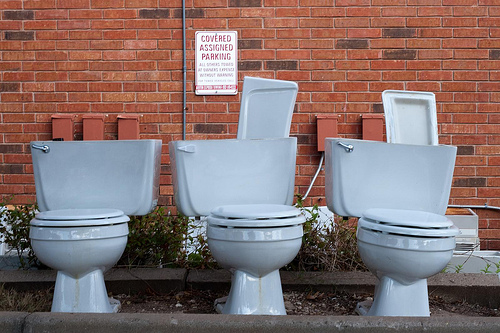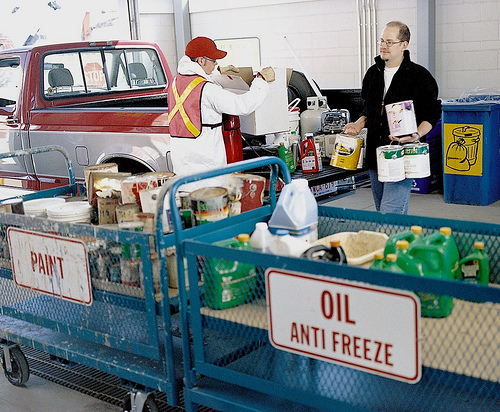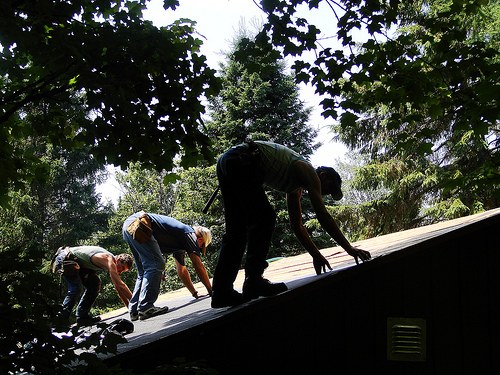On any given day you can tune into a renovation show on TV and find instructions on how to personalize your home. More and more the market asks us to go beyond a well-built dwelling in a good location. Now our personal spaces need to somehow reflect our sense of aesthetics and character.
So begins the renovation craze! But in this search for stylish and functional living spaces, where do we draw the line between want and waste? Does it really matter that a perfectly good fridge isn’t the same color as the dishwasher? Do you merely replace the old avacado toilet with a low flow, or opt instead for a sleek European sculpture that protrudes seamlessly from the wall, hiding all the plumbing because that stuff is unsightly?
Waste from home building and renovating constitutes approximately 57 percent of landfills, says Stephani Carter from EcoAmmo, an Alberta-based company specializing in sustainable research and education for the built environment. (Slogan: "Arm yourself with knowledge!") “People aren’t taught how to properly divert materials from the landfill,” she says.
 Credit: alamosbasement
Credit: alamosbasement
First things first. If you want to replace something that is fully functional, you can take the old appliances or leftover materials to the Habitat for Humanity ReStore so somebody else can have the chance to use what you no longer need. Perhaps those windows that ended up being the wrong size don’t have to go to landfill purgatory. At a ReStore you can expect to find light fixtures, appliances, lumber, doors, tile, paint, and, according to their website, even a kitchen sink. The ReStore isn't just a good option for offloading your unwanteds–it's also a smart first stop shop when you’re looking for materials for your own renovation.
If you do need to replace things that are at the end of their life, then it would be prudent to take them to their proper disposal sites. My town, Edmonton, sports an Eco Station that takes old fridges, post-Goodwill couches, and other non-reusable household items such as batteries, old paint cans, and light bulbs—some asking around online or offline might reveal that your town has a similar institution.
 Bringing paint to the Edmonton Eco Station. Credit: City of Edmonton
Bringing paint to the Edmonton Eco Station. Credit: City of Edmonton
Carter is quick to point out that even fast and inexpensive renovations can hurt the environment. Paint is major culprit in this department, particularly those that are laden with VOCs. “The most inexpensive products are those with the most toxins in them," says Carter. "It’s really inexpensive to build petroleum-based and chemical products.”
Carter stresses the importance of bringing in quality materials for your work, particularly if you’re doing the work yourself. You’ll spend more money, but you’ll do less damage to your body and your ecology: “It’s even more important to have good and proper materials because you’re bringing in toxic materials at the worst time with the initial off gassing.” Evidently only white paint is tested for VOC levels, but it’s actually the pigments for the colors that contain the most VOCs. “There is a third party certification to look for in paint," says Carter. "You want to look for a green seal of green guard and the symbol should be right on the can.” Brands that offer low-VOC paints include Cloverdale’s Horizon line, Benjamin Moore’s Aura line, and even Behr.
You may end up spending more money on quality green materials, but they can save money down the line. Flooring is another good example of this principle in action. “Hardwood is a good material, especially if you can get wood that is local,” Carter explains. “You can refinish it over and over again, I have an 80-year-old home and the floor is still standing.” This is compared to something like engineered wood, which you can only refinish so many times before the veneer is gone.
Credit: Denny Schmickle
Though something inexpensive may speak favorably to a budget, it’s important to reframe the way we think about these things and consider what the value of the renovation is. What value does it add to your home? How does it affect your health? Is it wasteful? In the pursuit of the dream dwelling, perhaps the lure of speed and price receives precedence over long-term value, which isn’t always monetary, and overall responsibility to the environment. Products come out contexts, and a context includes how manufacturers make or extract the material, how far the materials and products have to travel, and how renewable the resources are.
But the good news here is that shareable renovation does save money in ways that can compensate for the extra cash you pay for quality or local materials. Purchasing items from places like the Habitat for Humanity Restore saves cash, of course, but renovating with the environment in mind might also cause you to rethink your motivations and come up with a project of more modest dimensions.
If you’re really keen on making a change in your home without increasing your footprint, you could hire a re-designer like ecoDomestica. They’ll come into your space to help you reconceptualize the room with the things you already have. You can still get a room looking new, with some character, and with less impact on the landfill—and it will probably end up being cheaper than a full-blown renovation.
So when you’re thinking about making changes to your home, know there are a lot of earth friendly options that will make your home beautiful. The most important renovation tool you have is the power and creativity to consider your choices carefully, and that’s free.









